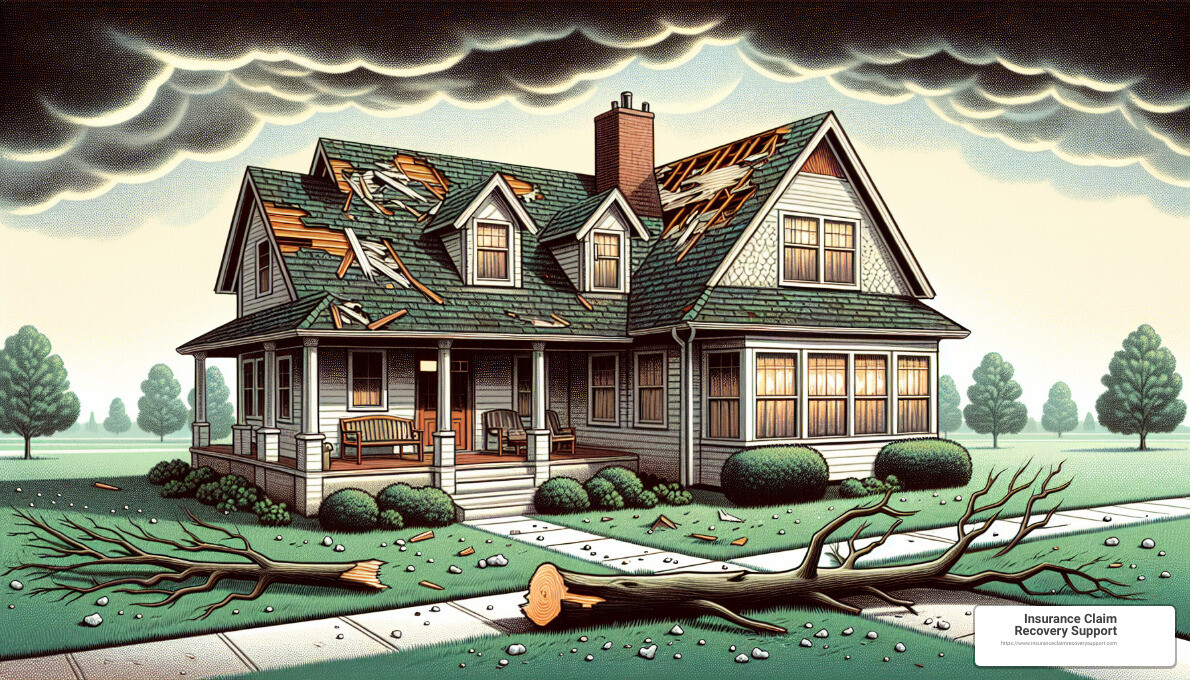When hailstorms hit, the damage to properties can be both surprising and devastating. Understanding hail storm insurance is crucial for property owners, especially those managing commercial buildings, multifamily complexes, homeowners associations, and other large-scale properties. The essence of this introduction is to quickly get you up to speed on what hail storm insurance covers, the type of damage you might encounter, and the basics of filing a claim.
In a nutshell:
– Hail storm insurance is part of a standard homeowners or property insurance policy.
– It covers damage to the structure of your building, as well as any personal property inside, from hail impact.
– Filing a claim for hail damage requires prompt action and thorough documentation.
Hailstorms don’t discriminate by geographical location; they can strike anywhere, putting your property at risk. Insurance basics for hail involve understanding what your policy covers, knowing how to identify the signs of hail damage, and being prepared to file a claim promptly to recover from any losses.
Whether it’s the roof, siding, windows, or interior damage, the impact of hail can lead to significant repair bills. Knowing how to navigate your insurance policy’s coverage for hail damage is paramount. This is particularly true in Hail Alley – the area spanning Texas, Colorado, Nebraska, and Wyoming, known for the most frequent and intense hail storms in the United States.
For property owners, comprehending these insurance basics and recognizing the potential for property damage is the first step towards mitigation and recovery after a hail event. Proper preparation and knowledge can make the difference between a straightforward claim process and undue stress and financial strain.

Understanding Hail Damage and Insurance Coverage
When hail clouds gather, so do concerns about the potential damage they can bring. Understanding how hail forms, the types of damage it can cause, and what insurance coverage can protect you, is crucial. Let’s break it down into simple terms.
Hail Formation
Hail starts as rain. Updrafts in thunderstorms push raindrops up into very cold areas of the atmosphere where they freeze. These frozen drops can loop up and down in the storm, gathering more water and freezing again until they become too heavy. Then, they fall as hail.
Damage Types
Hail can be as small as peas or as big as grapefruits. Even small hail can damage your property, but the big ones cause the most trouble. They can:
- Dent your car,
- Crack your windows,
- Damage your roof, and
- Destroy your garden.
Comprehensive Coverage
For cars, comprehensive coverage is your go-to for hail damage. It covers damage from things that aren’t collisions — like hail. If hail dents your car or breaks your windshield, comprehensive coverage can help pay for repairs. This coverage is optional, but very useful.
Homeowners Insurance
For your home, homeowners insurance usually covers hail damage. This includes damage to the structure of your home and may also cover damage to your belongings inside. But, there’s a catch. Some policies have specific deductibles for hail or wind damage, which might be higher than your standard deductible. This means you’d pay more out-of-pocket before insurance kicks in.
Also, if your roof is old, your insurance might only pay for its current value, not a new roof. This is called actual cash value coverage, and it could leave you paying a lot for a replacement.
Key Takeaways
- Hail can cause a lot of damage to both cars and homes.
- Comprehensive car insurance covers hail damage to cars. It’s optional but recommended.
- Homeowners insurance usually covers hail damage to homes, but watch out for higher deductibles and actual cash value coverage for older roofs.
Understanding your coverage is like having a good umbrella. It might not stop the storm, but it’ll help keep you dry. Next, we’ll dive into how to spot hail damage and what steps to take if your property has been hit.
How Hail Insurance Works
Navigating hail insurance can feel like trying to predict the weather—complicated and unpredictable. But don’t worry, we’re here to simplify it. Let’s break down the essentials: Comprehensive coverage, Rental coverage, the Claim process, and Deductibles.
Comprehensive Coverage
Think of comprehensive coverage as your all-weather friend. It steps in when hail decides to throw a tantrum, covering damages to your car that aren’t caused by a collision. If your car looks like it’s been in a battle with icy golf balls, comprehensive coverage is what you’ll lean on. This coverage is optional, but if hail is a frequent visitor in your area, it’s a wise choice.
Rental Coverage
Now, imagine your car is out of commission because of hail damage. You still need to get around, right? Rental coverage can be a lifesaver. It pays for a rental car while your vehicle is being repaired. This coverage is usually an add-on, so check with your insurer to make sure you have it.
Claim Process
Filing a claim might seem daunting, but it’s like following a recipe. First, document the damage with photos. Then, contact your insurance company to start the claim. An adjuster will inspect the damage, either in person or virtually, to determine how much the insurance company will pay for repairs.
- Document the damage: Take clear, detailed photos.
- Notify your insurance: Call or use their online claim service.
- Adjuster inspection: They assess the damage.
- Claim submission: Provide your documentation and wait for approval.
Deductibles
A deductible is what you pay out of pocket before insurance kicks in. It’s like the entrance fee to a concert. The higher your deductible, the lower your premium (the monthly cost for your insurance). But, if hail visits often, a lower deductible might save you money in the long run.
- Comprehensive Deductible: Applies to hail damage repairs for your car.
- Homeowners Deductible: This can vary, especially for hail. Some policies have a separate, higher deductible for hail and wind damage.
Understanding these components can help you navigate hail insurance more smoothly. It’s all about having the right coverage before the storm hits. This way, you’re not just crossing your fingers; you’re ready.
Next, we’ll explore how to identify and assess hail damage, ensuring you know exactly what to do when hail makes an unwelcome visit.
Identifying and Assessing Hail Damage
When hail hits, it can leave a trail of damage on your property. Knowing how to spot and assess this damage is crucial for filing an insurance claim and getting the necessary repairs done. Let’s break down the steps for identifying hail damage to your roof, exterior, and interior, and why professional assessment is key.
Roof Damage
The roof is often the first victim of hail. Here’s what to look for:
- Dents and Dings: Check for visible signs like dents on shingles or metal parts of the roof.
- Granule Loss: Hail can knock the granules off of asphalt shingles, exposing the base material. This can shorten the life of your roof.
- Cracks: Large hailstones can crack shingles.
Tip: Use binoculars to inspect your roof safely from the ground.
Exterior Damage
Hail doesn’t stop at the roof. It can wreak havoc on the rest of your property too.
- Siding and Windows: Look for dents on siding and broken windows or damaged window screens.
- AC Units: Air conditioning units can get dented or have their efficiency reduced by hail.
- Paint and Wood: Chipped paint or dents on wood surfaces are common signs of hail.
Interior Damage
Sometimes, hail can lead to damage inside your home.
- Leaks and Water Damage: After a hailstorm, check your attic and ceilings for water leaks or stains. Hail damage to your roof can lead to leaks.
- Insulation Damage: Water leaking into your home can also damage insulation, leading to higher energy bills.
Professional Assessment
While it’s important to do a preliminary check yourself, hiring a professional to assess hail damage is crucial. Here’s why:
- Safety: Professionals have the training to safely inspect damage, especially on roofs.
- Thoroughness: They know exactly what to look for and can spot damage you might miss.
- Documentation: A detailed report from a professional can strengthen your insurance claim.
Professionals use tools and techniques to assess damage accurately. They can also give you an estimate of the repair costs, which is valuable information for your insurance claim.
Remember: Quick action is vital. The sooner you identify and assess hail damage, the quicker you can file a claim and get repairs started. Ignoring damage can lead to more severe problems, like leaks or structural issues.
In the next section, we’ll guide you through filing a hail damage claim step by step, ensuring you have all the information you need to navigate this process smoothly.
Filing a Hail Damage Claim: A Step-by-Step Guide
Filing a hail damage claim might seem daunting, but it’s a necessary step to getting your property repaired and your life back to normal. Let’s break down the process into simple, manageable steps.
Documentation
First things first: document everything. As soon as it’s safe to do so after the storm, take detailed photos and videos of all the damage. This includes:
- Close-ups of any hailstones next to a ruler or coin for scale
- Wide shots of your entire property
- Specific damages to your roof, windows, cars, and any other affected areas
Keep a diary of dates and descriptions of the damage and any conversations with your insurance company. If you made any temporary repairs to prevent further damage, keep those receipts—they may be reimbursable.
Insurance Company Notification
Next, contact your insurance company as soon as possible to notify them of the damage. Most companies have a 24-hour hotline for claims. When you call, have your policy number ready and be prepared to describe the damage. They’ll likely give you a claim number—write this down, as you’ll need it for all future communications.
Adjuster Inspection
Your insurance company will send an adjuster to inspect the damage. This might happen within a few days or weeks, depending on the severity of the storm and how many other claims are being processed.
- Prepare for the visit: Have all your documentation ready to show the adjuster. This includes your photos, videos, and any repair estimates you’ve obtained.
- Be present: If possible, walk through the inspection with the adjuster. Point out all the damage you’ve noted. This is also a good time to ask questions about your coverage and the next steps in the claims process.
Claim Submission
After the adjuster’s visit, you’ll need to officially submit your claim. This may involve filling out forms and providing the documentation you’ve collected. Some key points to remember during this stage:
- Be thorough: Include all the information and documentation requested. Incomplete claims can be delayed or denied.
- Keep copies: Make sure you keep copies of everything you submit to your insurance company for your records.
- Follow up: Don’t hesitate to follow up with your insurance company if you haven’t heard back within a few weeks. Keep a record of all communications.
Remember: The goal of this process is to get the funds you need to repair your property. Being organized, thorough, and proactive can help ensure your claim is processed smoothly and efficiently.
The next section will cover some tips on preventing and mitigating hail damage to minimize future claims and ensure your property is protected year-round.
Preventing and Mitigating Hail Damage
Preventing and mitigating hail damage is key to protecting your property and avoiding costly repairs or insurance claims. Here’s how you can take proactive steps before, during, and after a hailstorm.
Preventive Measures
- Install Hail-Resistant Roofing: Consider materials rated UL 2218 Class 4, which have the highest resistance to hail.
- Use Protective Covers: For cars, outdoor furniture, and other vulnerable items, use padded covers or park cars in garages or under carports.
- Regular Maintenance: Keep trees and shrubs trimmed to prevent branches from falling on your property during a storm.
Immediate Actions Post-Storm
- Assess the Damage Safely: Once it’s safe, visually inspect your property for signs of hail damage, like dents on cars or damage to roof shingles, but avoid climbing on the roof.
- Cover Broken Windows and Skylights: This prevents water damage from ensuing rain. Use plywood or heavy-duty plastic sheeting.
- Document Everything: Take photos or videos of the damage for your records and potential insurance claims.
Long-Term Improvements
- Upgrade Building Materials: When repairing or renovating, choose materials designed to withstand severe weather, like impact-resistant windows.
- Landscaping as a Shield: Planting trees and shrubs in strategic locations can help shield your property from hail.
- Stay Informed: Follow local weather forecasts, especially during hail season, to prepare for storms in advance.
By implementing these strategies, you can significantly reduce the risk of hail damage to your property. While it’s impossible to prevent hailstorms, taking these steps can help minimize the impact, making your property more resilient and potentially saving you from filing a hail damage claim.
Even with all the right precautions, hail can still cause damage. If your property has been affected, reaching out to professionals like Insurance Claim Recovery Support can streamline the claim process, ensuring you get the support you need to recover from the storm.
Moving on, we’ll explore how to navigate hail damage claims in Texas, where hailstorms are a common challenge for homeowners and businesses alike.
Navigating Hail Damage Claims in Texas
Texas is no stranger to the fury of Mother Nature, with hailstorms hitting hard across the state. From Austin to Lubbock, and Dallas to San Antonio, every year brings its share of challenges. Understanding how to navigate hail damage claims in this region is crucial for homeowners and businesses alike. Here’s what you need to know:
Texas Cities and Hailstorms
- Austin, Dallas, Fort Worth, San Antonio, Houston: Major cities that frequently face the wrath of hailstorms. Each city has its own pattern of weather, but hail can strike anywhere and anytime within these regions.
- Lubbock, San Angelo, Waco: Known for their susceptibility to severe weather, including hail, these areas require residents to be particularly vigilant.
- Round Rock, Georgetown, Lakeway: While perhaps not as frequently hit, these areas are still at risk and residents should be prepared.
Texas Storm Damage News
Recent years have seen Texas topping the charts for hail damage claims. With almost 50,000 wind and hail damage claims filed in 2012 alone, the trend is clear. The state has been leading in hailstorm events, with an increase in both frequency and intensity. This highlights the importance of being well-prepared and informed.
Insurance Claim Recovery Support
When hail hits, the damage can be extensive and the claim process, overwhelming. This is where Insurance Claim Recovery Support steps in. Specializing in advocating for policyholders, they navigate the complex process of filing and settling hail damage claims. With a deep understanding of Texas’ unique weather patterns and insurance landscape, their expertise is invaluable.
Here’s how Insurance Claim Recovery Support can help:
- Expertise in Texas’ Weather-Related Claims: With Texas being a hotspot for hail damage, having an advocate who understands the local context is crucial.
- Maximizing Your Settlement: Insurance Claim Recovery Support works tirelessly to ensure you receive a fair settlement that covers your losses.
- Navigating the Claims Process: From documentation to negotiation, they guide you every step of the way, making the process as stress-free as possible.
Steps to Take After a Hailstorm in Texas
- Assess the Damage: Once it’s safe, check your property for hail damage.
- Document Everything: Take photos and notes of all damages for your claim.
- Contact Insurance Claim Recovery Support: Get in touch with experts who can guide you through the claims process.
- File Your Claim: With professional support, submit your hail damage claim to your insurance company.
- Stay Informed: Keep up with Texas storm damage news to stay prepared for future events.
Navigating hail damage claims in Texas can seem daunting, but with the right support and information, you can recover from the storm’s impact. Whether you’re in Austin, Dallas, or any part of this great state, knowing your rights and having expert support can make all the difference.
In the next section, we’ll wrap up with how Insurance Claim Recovery Support not only advocates for policyholders but also maximizes settlements, ensuring you’re not left to weather the storm alone.
Conclusion
Hail storms can hit hard and leave a trail of destruction in their wake. When your property is in the path of such a storm, the aftermath can feel overwhelming. That’s where we come in. At Insurance Claim Recovery Support, we’re more than just a service; we’re your partner in navigating the complex world of hail storm insurance claims.
Maximizing Settlements
Our mission is simple: to ensure you receive the maximum settlement possible. We’ve seen how insurance companies work and understand the tactics that can lead to lower payouts. Our expertise lies in meticulously documenting your claim, negotiating with insurance companies, and leveraging our deep understanding of hail storm insurance policies. This approach has consistently resulted in increased settlements for our clients, turning a stressful situation into a manageable one.
Policyholder Advocacy
We stand firmly on the side of the policyholder. You’re not just a number to us. You’re a person, a family, a business that’s facing a challenging time. Our advocacy extends beyond just filing claims. We’re here to educate you on your rights, guide you through the claims process, and provide the support you need to rebuild and recover.
Our team is equipped with the knowledge, experience, and dedication needed to navigate the complexities of hail damage claims. Whether it’s assessing the extent of damage, understanding the nuances of your policy, or fighting for a fair settlement, we’re with you every step of the way.
In Texas, where hail storms are a frequent menace, having a partner who understands the local landscape is invaluable. Our track record speaks volumes about our commitment to our clients across the state. From Austin to Dallas, and everywhere in between, we’re known for our relentless advocacy and unwavering support.
Conclusion
Hail storms don’t have to spell disaster. With the right preparation, knowledge, and support, you can navigate the aftermath with confidence. At Insurance Claim Recovery Support, we’re committed to ensuring that you receive the compensation you deserve, allowing you to focus on what matters most: rebuilding and moving forward.
If you’re facing a hail damage claim, don’t go it alone. Let us be your advocate, your guide, and your partner in recovery. Together, we can weather any storm.
Learn more about how we can help with your hail and wind damage insurance claims.
Navigating hail damage claims in Texas doesn’t have to be a solo journey. With Insurance Claim Recovery Support by your side, you’re equipped to face the challenge head-on and emerge stronger on the other side.









